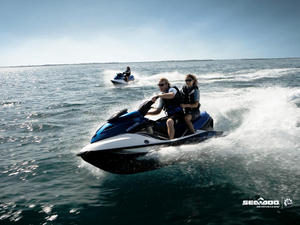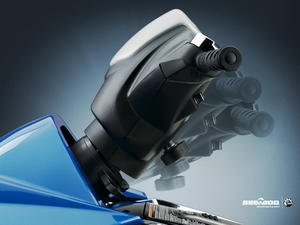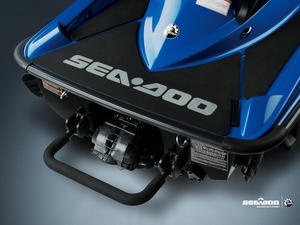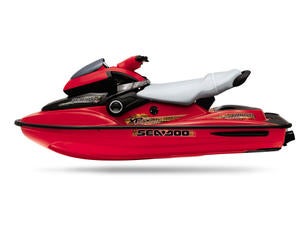PersonalWatercraft.com Q&A: Sea-Doo
Louis Levesque, Marketing Director
PersonalWatercraft.com sat down with Louis Levesque, marketing director for Sea-Doo, a division of Bombardier Recreational Products Inc. of Valcourt, Que., to discuss where the brand and the business is headed, how the company is responding to market challenges, and what we can expect in 2009 and beyond.
PersonalWatercraft.com: How is the personal watercraft business these days? How does it look in 2008 compared to 2007, and what do you see for 2009?
Levesque: The PWC business in North America is going well after many years of decline. The industry experienced double digit growth in 2005, and the volume is still growing, but only with single digit growth.
PersonalWatercraft.com: The personal watercraft business seems like quite a challenged market, with issues involving the environment, fuel prices and safety. How do you deal with these challenges in your overall business strategy?
Levesque: Sea-Doo personal watercraft is all about innovation, and we did address the environment, fuel and safety challenges. Put simply, Sea-Doo personal watercraft are some of the cleanest and quietest vehicles on the water.
Sea-Doos are some of the more environmentally-friendly boats on the water today. In fact, the entire Sea-Doo line-up is 85% cleaner than original EPA standards set 10 years ago. For example, the 2008 Sea-Doo GTI and GTI SE have a 130 HP 4-stroke that’s 91% cleaner than our recreational model from just seven years ago. All Sea-Doo models have earned the coveted 3-Star certification from the California Air Resource Board.
Additionally, Sea-Doo personal watercraft come with the D-Sea-Bel Sound Reduction System. A combination of resonators, acoustical foam and vibration-absorbing components work in unison to make Sea-Doos the quietest on the water. How quiet? About 70% quieter than in 1998, according to the January 2006 PWIA Report.
PersonalWatercraft.com: Sea-Doo is the largest manufacturer in this market and has the benefit of history and tradition that comes with the name. Besides these reasons, why should potential personal watercraft buyers choose Sea-Doo?
Levesque: We created the sport and we are still innovating year after year to deliver the ultimate fun for consumers and their friends and families. We invest millions in R&D to ensure our leadership positioning; we offer the most complete line up, the best performance and great unique features such as DESS (digitally encoded security system), OPAS (off-power assisted steering), D-Sea-Bel sound reduction system and Closed-Loop engine cooling.
PersonalWatercraft.com: Polaris got out of the personal watercraft business in 2006. What impact did that have on the market overall and your business, specifically?
Levesque: None. The industry increased despite this and we captured more volume.
PersonalWatercraft.com: Sea-Doo does not make stand-up machines, which are predominant in racing, and as we understand it you prefer to focus on recreational enthusiasts. But racing attracts attention and, presumably, drives sales. What is your reason for this decision?
Levesque: We are in racing but not with stand-up. We lead racing with PWC, and we’ve won many races over the years around the world. For example, Sea-Doo won the last three World Offshore Endurance Championship in Oleron, France. We also won a lot of races in many categories at the World Finals, in Havasu, Ariz.
PersonalWatercraft.com: What are the biggest challenges to growth in the PWC market? Some might say its concern about the environment or fuel costs or safety issues, while your CEO, Jose Boisjoli, has said one major difficulty is much lower trade-in business than BRP expected. How would you characterize the biggest challenges these days?
Levesque: We have made major progress on environmental, fuel and safety challenges, but some people still believe that we haven’t done anything, so we still need to work hard to change that perception. The personal watercraft industry did a lot more work on the environment and safety than the general boating industry. We must consistently communicate this.
Additionally, as Jose said, we need to renew the personal watercraft park. There are more than a million units in North America that are still in usage; we need to renew that fleet (trade-in). New technology is the key for changing units, and Sea-Doo is committed to this industry and we will bring new innovations as we have done in the past.
PersonalWatercraft.com: What are some examples of technology that has spilled over from other parts of BRP’s business, for example, products or technology developed for Ski-Doo?
Levesque: We always develop technologies that are specific to each industry. However, we also look at the possibility to transfer innovations when applicable. We did that with our advance DESS system (digital encoding security system) and our closed loop cooling system on Sport Boat. For sure we also share our manufacturing and engine innovations, but as I said this must fit our industry positioning.
PersonalWatercraft.com: What is the next step for Sea-Doo technology—what might we see over the next few years?
Levesque: Unfortunately, as you can imagine, I can’t share our innovation plan. But it is part of our DNA, and I can guarantee you that Sea-Doo will bring new innovations in the future. Stay tuned.
PersonalWatercraft.com: Where, in terms of either geography or machine class, do you see the biggest opportunities for growth?
Levesque: There are a lot of growth opportunities. I see a lot of potential for a family oriented unit—there are lots of people looking for a cool, fun family activity. Also, there is definitely a significant pool of enthusiasts who want a performance machine.
PersonalWatercraft.com: Being as honest as you can, what developments do you see competitors introducing to the market that you admire?
Levesque: I always admire innovations, and for sure all competitive OEMs innovate too. It’s a very competitive environment and this makes it fun. We are competing with serious names like Yamaha, Honda and Kawasaki, which are investing in R&D too. We just need to make sure we stay ahead and we find the edge that will make us leader.
And On a Personal Note…
My most favorite machine of all time is:
From a design standpoint, the Sea-Doo XP, which has won designs of the decade and watercraft of the century awards. This watercraft performance was very good, too, but I must admit that the 2008 Sea-Doo X series is now the performance benchmark. Nothing can beat the incredible acceleration—0 to 50 MPH in 2.9 sec, faster than a Ferrari F430. I like adrenaline, therefore I like this new performance benchmark
If I wasn’t involved in the PWC business, I would:
I would still work in marketing but maybe for car company such as BMW or Porsche. I like performance, adrenaline and technical innovations, so I will always work for a company that delivers on those attributes.
My ideal riding partner would be:
I ride a lot as part of my job, and on top of that it’s fun. I’ve ridden with a lot of partners over the years, and I like that diversity but I always enjoy riding with my family and my closed friends because I can relax and share my passion with them.
Get PersonalWatercraft.com in your Inbox!
Like PersonalWatercraft.com on Facebook
Comments
Most Popular

2025 Yamaha JetBlaster PRO 2-Up Review

Remembering the Sea-Doo XP

2024 Kawasaki Jet Ski STX 160X Review

Whatever Happened to the Wetbike?

2025 Yamaha JetBlaster Review
















 Your Privacy Choices
Your Privacy Choices